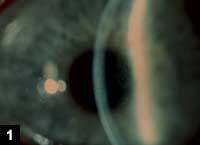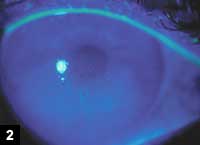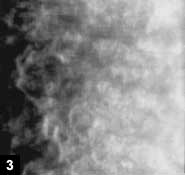Man complains of blurry vision that improves during the course of the day
Diffuse corneal edema and diffuse microcystic edema were observed in both eyes. Small bullae was noted in the right eye.

A 48-year-old man was referred by an optometrist for management of blurry vision. He reported morning blurring of vision in both eyes, which improved by mid-day. While using hypertonic saline drops, his vision improved. There was no pain or discomfort associated with this condition.
The patient’s ocular and medical histories were noncontributory. He had no medication allergies and took only an aspirin daily. He did not use tobacco products and drank alcohol occasionally. The family history was also negative.
 Isabel M. Balderas |  Tom Hsu |
Examination
The patient’s visual acuity was 20/30 in the right eye and 20/50 in the left eye. With manifest refraction, his vision was 20/30 in each eye. IOP was 13 mm Hg in the right eye and 12 mm Hg in the left eye. Pupillary examination was normal with no afferent defect. Confrontation visual fields and extraocular muscle movements were normal.
On slit lamp examination, there was diffuse corneal edema in both eyes (Figure 1). With fluorescein staining, diffuse microcystic edema was evident in both eyes, as well as some small bullae in the right eye (Figure 2). The conjunctiva was white and quiet in both eyes. The anterior chamber was deep and quiet. The iris was round and reactive. Trace nuclear sclerotic cataracts were present. The posterior segment examination revealed normal discs, fundi, vessels and peripheral retina.
|
|
Yoon MK, Soukiasian SH |

What is your diagnosis?
Corneal edema
The differential diagnosis for corneal edema is broad, although the onset of symptoms can play a role in narrowing the differential. Fuchs’ endothelial dystrophy is a well-known cause of corneal edema. This typically affects adults in their seventh decade and beyond. There is progressive failure of corneal endothelial cells, resulting in corneal thickening and vision loss. Guttae, mushroom-shaped excrescences of Descemet’s membrane are seen in the central cornea. Although the patient is younger than the typical symptomatic patient, this remains high on the differential diagnosis.
Posterior polymorphous dystrophy is an uncommon corneal condition affecting Descemet’s membrane and the endothelium. Typically bilateral, the corneal changes cause irregularities of the posterior cornea. Multilayered endothelium and focal excrescences of Descemet’s membrane may manifest clinically as “snail tracks.” Stromal edema and epithelial edema occur only in advanced cases.
Congenital hereditary endothelial dystrophy is an uncommon cause of corneal edema and presents in childhood. Symptoms include corneal clouding, light sensitivity, tearing and occasionally nystagmus. The autosomal recessively inherited form typically appears at birth but does not progress. The dominant form presents at approximately 1 to 2 years of age and can progress throughout childhood.
Common causes of corneal edema in adults are pseudophakic or aphakic bullous keratopathy; however, this patient has never had ocular surgery.
Patient course
Corneal thickness was 533 µm in the right eye and 482 µm in the left. Over the subsequent 11 months, corneal thickness increased to 638 µm in the right eye and 582 µm in the left. Best corrected visual acuity decreased to 20/100 in the right eye and 20/80 in the left. Specular microscopy showed significantly decreased endothelial cell density, pleomorphism and polymegethism (Figure 3).
Despite treatment with hypertonic saline drops and ointment, the patient’s vision continued to worsen. Due to the progressive vision loss with edema, the patient underwent penetrating keratoplasty in the right eye. Pathologic examination revealed corneal stromal edema (Figure 4). There was a severely thickened Descemet’s membrane with attenuated endothelium. No guttata were present on the pathologic sections.
After surgery, the patient’s BCVA improved to 20/25 in the right eye. PK has been scheduled for the left eye.
|
|
|
Discussion
Fuchs’ endothelial dystrophy was first described by Fuchs in 1910. It is a noninflammatory, slowly progressive loss of endothelial cells resulting in corneal edema. Although typically a bilateral condition, a large degree of asymmetry may exist. A dysfunction of the sodium-potassium ATPase pump results in an attrition of endothelial cell function. This results in the presence of corneal edema.
Although corneal guttata are commonly seen, Fuchs’ endothelial dystrophy is an uncommon condition. However, it accounts for approximately 15% of PK surgeries. Women have an approximately 4:1 prevalence of the disease. The inheritance pattern is believed to be autosomal dominant.
On examination, early findings are central guttata. These have a beaten metal appearance. These focal excrescences are abnormal elaborations of basement membrane and collagen made by distressed or dystrophic endothelial cells. Although a hallmark of Fuchs’ dystrophy, they are not pathognomonic for the condition.
In this case, Fuchs’ endothelial dystrophy without guttata was found. This has been described in the literature previously. It is believed that the endothelial cells die before being able to secrete the excrescences.
Four clinical stages of Fuchs’ endothelial dystrophy have been described. Stage 1 is asymptomatic, with normal vision and guttata on examination. Stage 2 presents with a painless decrease in vision, which may be worse in the morning and improve during the day. Stage 3 is present once bullae are formed. Stage 4 is characterized by subepithelial fibrosis.
Treatment typically begins with hypertonic solutions or ointments. Reducing IOP to less than 20 mm Hg may provide less of a hydrostatic pressure gradient of fluid into the cornea. If epithelial erosions or bullae are present, bandage contact lenses or anterior stromal puncture may be used. However, with severe disease, PK may need to be performed. More recently, surgeons are performing endothelial keratoplasty with or without Descemet’s stripping. By transplanting healthy endothelial cells, improvement in corneal edema can result.
For more information:
- Michael K. Yoon, MD, and Sarkis H. Soukiasian, MD, can be reached at New England Eye Center, Tufts University School of Medicine, 750 Washington St., Box 450, Boston, MA 02111; 617-636-4219; fax: 617-636-4866; Web site: www.neec.com.
- Edited by Isabel M. Balderas, MD, and Tom Hsu, MD. Drs. Balderas and Hsu can be reached at New England Eye Center, Tufts University School of Medicine, 750 Washington St., Box 450, Boston, MA 02111; 617-636-4219; fax: 617-636-4866; Web site: www.neec.com. Drs. Balderas and Hsu have no direct financial interest in the products mentioned in this article, nor are they paid consultants for any companies mentioned.
References:
- Abbott RL, Fine BS, et al. Specular microscopic and histologic observations in nonguttate corneal endothelial degeneration. Ophthalmology. 1981;88(8):788-800.
- Adamis AP, Filatov V, Tripathi BJ, Tripathi RC. Fuchs’ endothelial dystrophy of the cornea. Surv Ophthalmol. 1993;38(2):149-168.
- Kirkness CM, McCartney A, et al. Congenital hereditary corneal oedema of Maumenee: its clinical features, management, and pathology. Br J Ophthalmol. 1987;71(2):130-144.
- Oh KT, Weil LJ, Oh DM, Mathers WD. Corneal thickness in Fuchs’ dystrophy with and without epithelial oedema. Eye. 1998;12(Pt 2):282-284.
- Patel A, Kenyon KR, et al. Clinicopathologic features of Chandler’s syndrome. Surv Ophthalmol. 1983;27(5):327-344.
- Rodrigues MM, Krachmer JH, et al. Fuchs’ corneal dystrophy. A clinicopathologic study of the variation in corneal edema. Ophthalmology. 1986;93(6):789-796.
- Yanoff M, Duker JS. Ophthalmology. 2nd ed. Elsevier; 2004:425-430.




